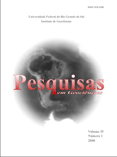Determination of Net Sediment Transport Patterns in Lirquén Harbor, Chile, Through Grain-size Trend Analysis: A Test Of Methods
DOI:
https://doi.org/10.22456/1807-9806.19581Palavras-chave:
Sediment transport patterns, grain-size trends, GIS, Lirquén Harbor, southern Chile.Resumo
During June 1997, bottom sediment samples were collected at 76 stations on a rectangular grid in a small port (Lirquén Harbor, south-central Chile) facing siltation problems. The spatial changes in grain-size parameters, analyzed by using three different methodologies to infer net sediment transport paths, are compared with the measured water circulation of the study area and sediment dispersal patterns on aerial photographs. A Geographical Information System (GIS) is used to determine the degree of similarity between the results of the three grain-size trend methodologies. The results of this study confirm that because of its formulation and underlying assumptions, the McLaren-Bowles methodology tends to confuse the space-scale of sediment transport processes. In this way, the obtained transport patterns are in poor correlation with the observed hydrodynamics and aerial photographs and they seem to represent a combination of the spatial macroscale and mesoscale sediment transport processes existing in Concepcion Bay and in Lirquén Harbor, respectively. On the contrary, because the results yielded by the Gao-Collins and Le Roux methodologies correlate well with these studies, it is suggested that both methodologies be applied in combination to allow a better representation of local net sediment transport patterns, especially in estuarine environments where multiple sediment sources exist. Spatial analysis suggests that transport pathways obtained through these two methodologies represent the mesoscale sediment circulation existing in Lirquén Harbor. This study also emphasizes the importance of applying a statistical test to the transport trend vectors obtained using the GSTA program of Gao (1996), as these may erroneously reflect sediment transport direction. Lastly, the analyzed data and the results of the models are combined to determine the sediment transport regime existing in Lirquén Harbor.



